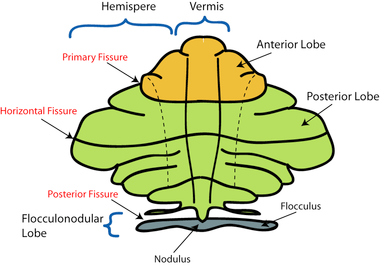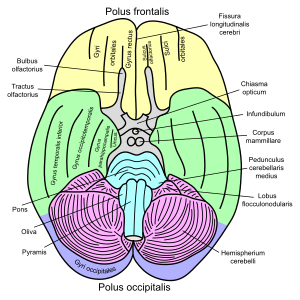Flocculonodular lobe
The flocculonodular lobe (vestibulocerebellum) is a lobe of the cerebellum consisting of the nodule and the flocculus. The two flocculi are connected to the midline structure called the nodulus by thin pedicles. It is placed on the anteroinferior surface of cerebellum.
| Flocculonodular lobe | |
|---|---|
 Schematic representation of the major anatomical subdivisions of the cerebellum. Superior view of an "unrolled" cerebellum, placing the vermis in one plane. | |
 Basal view of a human brain | |
| Identifiers | |
| NeuroNames | 679 |
| NeuroLex ID | birnlex_904 |
| TA | A14.1.07.301 |
| FMA | 72253 |
| Anatomical terms of neuroanatomy | |
This region of the cerebellum has important connections to the vestibular nuclei and uses information about head movement to influence eye movement. Lesions to this area can result in multiple deficits in visual tracking and oculomotor control (such as nystagmus and vertigo), integration of vestibular information for eye and head control, as well as control of axial muscles for balance.[1] This lobe is also involved in the maintenance of balance equilibrium and muscle tone.[2] The most common cause of damage to the flocculonodular lobe is medulloblastoma in childhood.
References
This article incorporates text in the public domain from page 791 of the 20th edition of Gray's Anatomy (1918)
- Chapter 8B: Cerebellar Systems
- Mathias Baehr; Michael Frotscher (2012-01-25). Duus' Topical Diagnosis in Neurology: Anatomy, Physiology, Signs, Symptoms. Thieme. ISBN 978-3-13-164455-8.